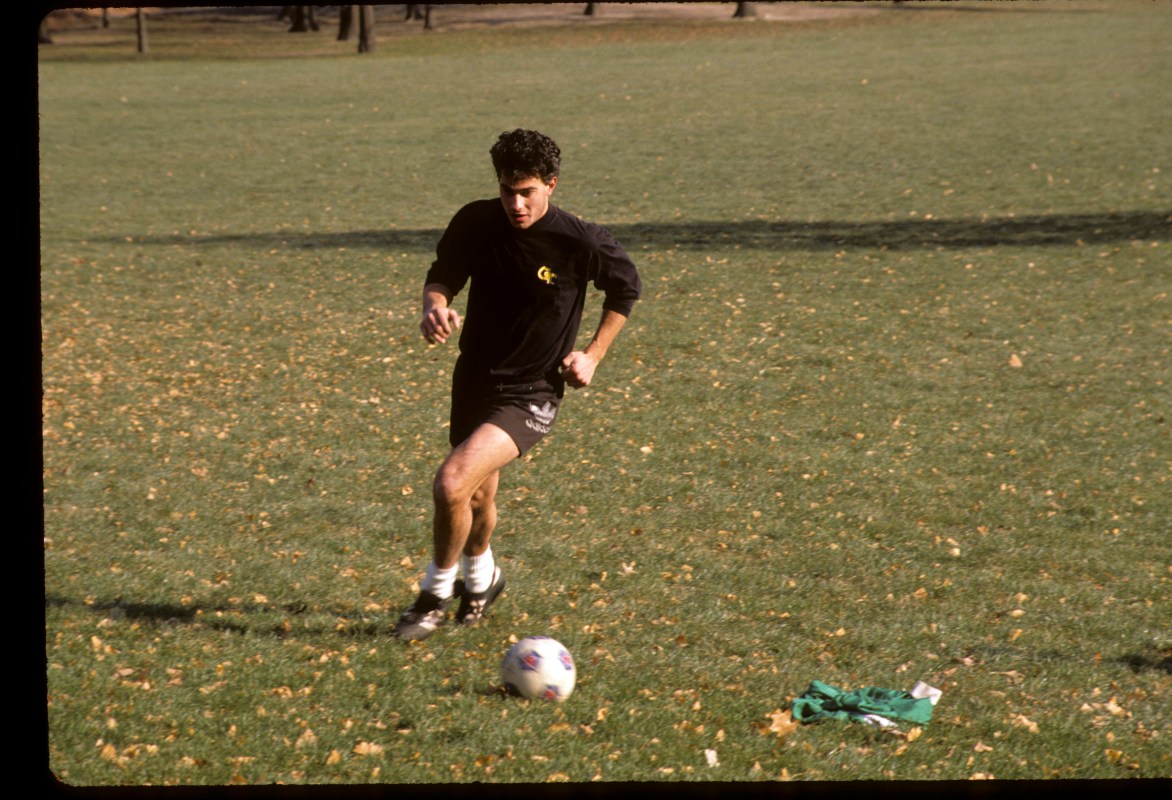Soccer’s a humbling game. Whatever your personal definition of being “in shape” is, the sport will likely find a way to remind you of some other area you’ve been neglecting.
Last fall, during my team’s season opener — we play in an intermediate league at Brooklyn Bridge Park in New York — I hit my top speed on open grass in order to make a tackle. I got to the ball in time, but I was barely holding back bile on the sideline after. I felt a little embarrassed. I’m the runner guy in my friend group. The weekend prior I’d logged more than 10 miles along the Hudson River. But the simple truth was that I hadn’t run quite that fast in a long time.
With fall footy starting up again for millions of sort-of-in-shape adults across America, we asked some soccer coaches and personal trainers to steel us for all facets of soccer conditioning. That includes cardio, sure, but also high-intensity anaerobic training (gym-speak for sprints!), offbeat weightlifting exercises and mobility work that will keep injuries at bay all season long.

Is It an Endurance Sport?
Considering that softball and soccer are two of the most popular adult intramural sports, the difference in physical exertion is somewhat absurd. According to research from Runner’s World, the average professional baseball player travels just 0.0375 miles per game. That’s only a couple hundred feet. Pro soccer players regularly hit seven miles, meanwhile, and some midfielders get close to double digits. Even if you’re playing six-on-six or seven-on-seven on a smaller field with smaller goals, the fact remains: you’re going to be running around for more than an hour. Which means soccer requires some cardiovascular chops. Right?
Well, yes, to an extent. If you don’t normally challenge your legs or lungs with prolonged movement, it’s a good idea to prepare for the season by incorporating some miles around your local track or neighborhood. Nelson Johnson, a U.S. Soccer Federation Licensed Grassroots Referee, recommends building a reasonable base. “I always look back to the conditioning we did for my high school varsity team,” he says. “Our early workouts would be primarily focused on building endurance. Long jogs that aren’t not worried about speed, starting in the one to two mile range…then building up to four to five mile workouts.”
Johnson recommends getting creative with how you allocate this mileage, too. “Rotate the locations for runs,” he says. “I can’t even begin to force myself to run 20 laps around a track, but that same distance down and back on a riverside trail is significantly easier to manage.”
Still, while long-distance running will help you find your wind ahead of a few months of competition, it isn’t as necessary (or as helpful on the pitch) as you might think. This is where I got tripped up last fall, assuming my habitual 90-minute runs would have me feeling fit as a fiddle during the games. As Zack Phillips, a strength trainer at the University of Texas at Austin, explains, “Long-distance running builds an aerobic base, but it will cause the loss of quickness and power. While preparing for the season, I would not want my athletes doing low-intensity runs.”
Ever seen those sports-bra-looking monitors that soccer players wear under their kits? Those things have cataloged databases full of performance metrics, which illustrate that while many miles are run during a game, there’s no rhyme or reason to the varying speeds at which they’re run. Long-distance runners may start or finish a bit quicker than their pace throughout a race, but generally settle into a steady clip. Soccer is different. It’s a sport with whistles, corners, breaks and, once in a while, a mad dash for the ball, which can see players hit upwards of 20 miles per hour.
Whatever your sprint speed is, it’s more important that you access it than prance around the field to a perfect pace. Not to mention, excessive weekly mileage could leave your legs exhausted and/or susceptible to injury — which could lead to you missing games or exacerbating imbalances during the game. (This does happen to be marathon training season, so be careful if you’re simultaneously playing in a league.)
A Guide to Sprinting After the Age of 30
According to internet lore, there’s a point where adults never hit their max speed again. Let’s change the narrative.Train Fast to Play Fast
If not knocking out miles, what would a trainer like Phillips recommend players prioritize instead? Think sprints, a million different ways. “When it comes to building speed, the bottom line is you must train fast to play fast,” he says. “I would want them developing power by running fast intervals and incorporating change of direction. This is a much quicker way to build soccer fitness, while maintaining speed and strength.”
Obviously, few soccer players — and much less those playing in a Wednesday night league with friends — want to line up on side of the pitch and sprint to the other, back and forth, Miracle-style. But sprints generally conjure an unfair association in sports, as, say, a way to “punish” athletes after a bad practice or poor performance. In reality, there are myriad ways to reap the benefits of high-intensity anaerobic training. You can run stairs, do hill sprints, create an obstacle course with cones or fire up an old-fashioned track workout. Whatever you choose, the key is that you’re activating those powerful “fast-twitch” muscle fibers.
As a soccer field is generally around 100 yards and the likelihood of you having to sprint the full length of the field more than once or twice a game is quite small, I would focus on bursts within the straightaway of a traditional track, which is 100 meters. Try sprinting those straightaways and very lightly jogging the curves, over a total of four laps.
You also might consider a workout vouched for by Rhett Lewis, an Australian who worked in professional soccer clubs in England for 10 years and is a UEFA ‘A’ Licence Soccer Coach. Lewis looks for some compromise between endurance training and hard running. His instructions: “Run around the soccer field for four minutes at 80% of your maximum speed. Then take a 30-second break. The cycle should be repeated three more times.”
And once you’re done with that, move to “long sprints.” Your marching orders: “Start on the corner of the soccer field. Sprint from one corner of the field to the other corner at maximum speed. Rest for 30 seconds before sprinting to the adjacent corner flag. Take a 30-second break. Take a diagonal path to the opposite corner sprinting at full speed. Spend 30 seconds catching your breath before sprinting back to the original starting position.” (If you plot those four points on a piece of paper, it should make the shape of an hourglass.) Why run directly on the field? Running on a track or up a cement hill is great, but it’s important to get a feel for the terrain, whether it’s grass or turf.
Mobility Matters
Rec soccer leagues are going to have their injuries. They’re unavoidable when human adults used to sitting behind desks suddenly spend an hour a week kicking, elbowing and crashing into other human adults. Usually, these injuries are minor. They’re badges of honor, if anything (in our team group chat, people will send photos of bizarre toe bruises and knee “turf burns”). But serious injuries can happen, and bulletproofing your body against that possibility should absolutely be seen as another facet of getting into soccer shape.
For starters, treasure your mobility. Soccer is a game of quick decisions that mandate quick, lateral cuts. In order to avoid straining something in your lower half, it’s crucial that you prepare your body accordingly before training or a game. That means warming up with non-negotiable dynamic stretches, hitting your muscles with a roller or massage gun if you’ve got one and engaging in static stretching after the game, when the muscles are warm. Your lower back will thank you kindly the next morning (especially if you celebrate with beers after the game — hangovers exacerbate muscle soreness!).
Mind Your Hammies
As for one area to really monitor on the pitch? Your hamstrings. Hamstring strains and tears are notorious for soccer players hustling down the field. Make sure to perform dynamic, single-leg hamstring stretches before every game (helpful visuals here). And as those strains generally occur when players switch into their top gear, personal trainer Daniel Richter advises getting a feel for your acceleration before the game starts.
Richter, who is also a soccer coach, says, “This risk is amplified in adults unused to sprinting, who suddenly sprint at maximum capacity during a soccer game. In training, consider performing four sprints of 30 seconds each. Don’t go at max speed in those first few workouts. Start slow to let your body get used to it, and aim to run a little faster each workout. Repeat this workout about twice per week, and increase the number of sprints to five after two weeks and to six after four weeks. Don’t be afraid to rest; upwards of four minutes rest between sprints is a common training protocol. That will allow you to perform better in the sprints and get a better training effect.”
In other words, whatever sprinting regimen you choose to prepare for your season, be mindful of how you much you demand of those hamstrings. They’ll be more responsive (and better protected once the games start) because of it. In addition to stretching, though, it’s also a good idea to strengthen the area. The stronger the core and lower half are, the less likely you are to sustain an injury — and the more likely you are to shake off defenders, pull off difficult twists or shifts in direction, and put the ball in the back of the net.
For the hamstrings, Richter recommends a movement known as the Nordic hamstring exercise. It’s highly respected in the sports performance field, and you can do it with the aid of a partner or a machine. He supports leg curls, Romanian deadlifts and kettlebell swings to further support the hamstrings, and across the rest of the lower half, he vouches for single-leg movements “such as lunges or Bulgarian split squats.” He adds, “Since you stand on one leg in many situations in soccer where you need to exert force (like when you’re changing direction or accelerating in a sprint), one-legged strength exercises are a very effective form of training.”
Other Moves to Try
There are a variety of other moves that will help bolster your body for the pitch. Toe raises are great for the muscles around your ankles; box jumps will create more powerful quads; wood choppers reinforce your obliques for self-assured turns. Casual observers might not associate soccer with the weight room, considering most of the game’s stars aren’t walking around with Marvel Universe torsos, but that’s a misinterpretation. Strength training is both a line of defense against injury and a legitimate method for upping your game on the field.
Ultimately, playing in a rec soccer league is worth it for the mental health benefits alone. Getting to run around as an adult is all too rare, and I’ve come to cherish these seasons. Still, the potential physical benefits are right there, too. I truly appreciate the kick in the pants that playing in a league has given me on the conditioning front. Remember: you don’t have to be a serious athlete to take your body seriously.
The Charge will help you move better, think clearer and stay in the game longer. Subscribe to our wellness newsletter today.


























